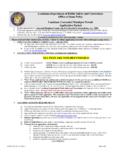Transcription of Veterinary Medical Math Packet - USU
1 Veterinary Medical Math Packet Introduction There should be no surprise that veterinarians use math in their jobs, but if it is, please allow me to elaborate. To give just a short peek into the useful world of mathematics in your future career, we can reference , which provides a simple article outlining some of the more useful aspects of mathematics to veterinarians. In their article How Do Veterinarians Use Math in Their Jobs? by Stephanie Fagnani, she writes: Veterinarians receive an education that is heavily focused on science and math to practice their trade. Whether they decide to treat only dogs and cats or less common pets such as guinea pigs and birds, they need to know how to use math to properly calculate billing charges, medication doses and surgical procedures to preserve the health of their patients.
2 That being said, included in this Packet you will find reference material for the following applicable math skills and topics: I. Basic Algebraic Operations II. Unit Conversions III. Scientific Notation & Significant Digits IV. Dosage Calculations V. Fluid and Solution Calculations VI. Basic Statistics Preparing for the basic skills exam will be left up to you during the remainder of the summer. Be advised, the topics listed above were provided mainly by your professors for your first two years of the program and have been selected as topics that, when understood, will greatly help you in your academic endeavors, as well as in your professional career. Kristi Reutzel Veterinary Medical Math instructor Unit 1- Basic Algebraic Operations I.
3 Multiplication and Division 1. Multiplication and division of two or more positive numbers: When two or more positive numbers are multiplied or divided, the result will be a positive number. Examples: 25 x 5 = 125 25 5 = 5 or 2. When two negative numbers are multiplied or divided, the result will be a positive number. Examples: (-3) x (-3) = 9 (-15) (-3) = 5 (Remember: two negatives become a positive) 3. When positive and negative numbers are multiplied or divided together, the result will be a negative number. Examples: (-15) x (3) = - 45 (-20) (4) = -5 4. When an equation contains numbers within parentheses, that mathematical operation should be performed first. Examples: (5-3) x (-4 2) = (2) x (-2) = -4 (5x2) (-10 5) = (10) (-2) = -5 II.
4 Order of Operations Above we saw some basic examples of some of the possible operations in equations, but which one do we do first? Given the following numeric statement: 4*5+2= ? what would be the solution? Would we add first then multiply? 4*5+2=4*7=28 Or would we multiply first, then add? 4*5+2=20+2=22 If you chose the second one, you chose correctly. There is a set order to the way we perform our operations within some numerical expression (as you can see, without a set order we can get very different answers). In the numerical world there is a set hierarchy or ranking of operations, and we perform the top tier first, followed by the second tier, and so on, it looks like this: 1. Perform parts involving Parenthesis 2. Execute any form of Exponents 3.
5 Manipulate any operation involving Multiplication and/or Division 4. Additionally perform any sort of Addition and/or Subtraction III. Solving for Unknown Variables The same basic rules apply when you have an unknown variable, as when we are simply given integers, or any number really. The only difference is that we need to remember to keep track of our variable. 1. To solve for an unknown variable when given an addition or subtraction problem, we simply need to get the variable by itself, by undoing what was done to it. Examples, solve for X: is given, so we know that whatever X is, we will need to add 2 to it to make 5. So, if we took away 2 from both sides, we will be left with just X (we will have solved for X). Thus, we do exactly that, then we are left with: which yields our result: 2.
6 The same concept of undoing what has been done to our variable goes on to apply to multiplication and division as well. All we are trying to do is get our variable alone on one side of the equals sign. We undo multiplication by division, we undo division by multiplication; they are inverses of one another. Examples, solve for X: Here, we have been given a problem that has 2 parts, multiplying 4 times X, and dividing that quantity by 5, yielding a result of 4. So, following our process of undoing , lets first multiply both sides by 5 (getting rid of the division): This then simplifies to the following: Now, we are left with simply 4 times the quantity X yields 20, so to get rid of multiplication, we will divide both sides of the equality by 4: In doing so, we are left simply with: IV.
7 Ratios In an effort to include something on ratios for your later classes, why not do it here at the beginning? Ratios are used to compare two groups (such as number of men to women in a room), and can be written as values separated by a colon (:), or in a form that looks like a fraction. But, ratios and fractions are different; fractions such as compare the 1 desired group to the total, not comparing two groups. For instance, when we have a room with 30 people in it, 10 men and 20 women, using fractions, we can say men represent 10/30 people, or reduced, men represent 1/3 of the people in the room. However, we would say that the room has a man:woman ratio of 1:2 or (ratios are always reduced, we got 1:2 after reducing 10 men : 20 women).
8 For more information, please see: V. Practice Problems (to be done without a calculator) Simplify (Solve) the following mathematical statements: 1. 24 x 12 = 2. 150 x (-4) = 3. 230 5 = 4. (19 + 5 - 3) (-7) = 5. ((-40) (-20)) x 16 = 6. + + + 15 = 7. = 8. 22 + 11 11 = 9. = 10. Solve for the missing variable, simplify your answer. 11. (2y 5) = 7 12. (2v-5v) 3 = 1 13. 23a 7 = 2a + 14 14. 3(2x) -5 = 7 15. Simplify the following relations, express each situation as a ratio. 16. 12:24 17. 3:9 18. 5/25 19. A certain recipe calls for three times as much flour as water. 20. There are 38 people in a room 24 men and 14 women. VI. Answers 1. 288 2. -600 3. 46 4. -3 5. 32 6. 7. 8. 23 9. 10. 15 11. y=6 12. v=-1 13.
9 A=1 14. x=2 15. x=25/9 16. 1:2 17. 1:3 18. 1/5 19. 3:1 or 3/1 20. 12:7 or 12/7 Unit 2- Unit Conversions I. General Idea The main purpose of converting units is to start with some amount in one unit and to try to find some equivalent amount in a different set of units for a specific purpose. We will get into the more practical applied problems in the later units, but for now we need to understand the general idea. Units, such as: gallons, cups, ounces, inches, liters, grams, etc. all have a specific and set meaning as well as an amount fixed to them. If we have 1 gallon of a solution, but we want to know how many quarts it is, we cannot just change the units and say that we then have 1 quart of the solution. It just doesn t work (and it should be clear why since 1 gallon of a solution does not equal 1 quart of the same solution).
10 We need to actually convert the units; keep in mind that all we are really doing is changing the way the numbers look, we should still have the same amount that we had to start with. II. Relations As stated above, units give us a clear understanding of the amount, weight, mass, distance, etc. of something, so our units themselves are pre-defined. That being said, we can have a decent idea of the relationship between 2 such units. For instance: it is a fact that 1 gallon of a substance = 4 quarts of that same substance, 1 liter of a substance = 1000 milliliters of the same substance. The number and unit name may look different, but the actual amount they are describing is the same. That is the key to unit conversion. III. The Number One From the previous review unit (and from previous mathematics classes your whole life through) you have been taught that the number 1 can take on all sorts of different disguises, it can look many different ways, but it always holds the same value.








